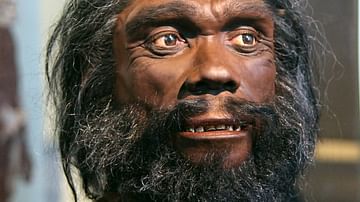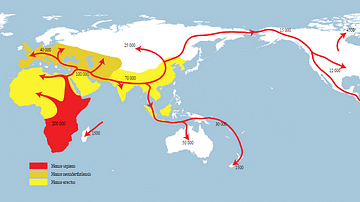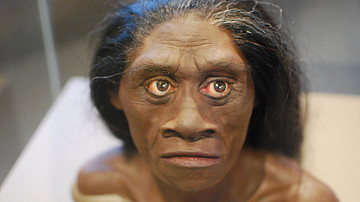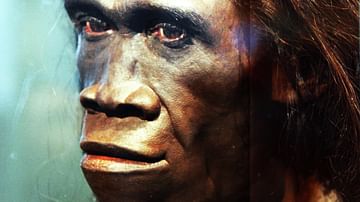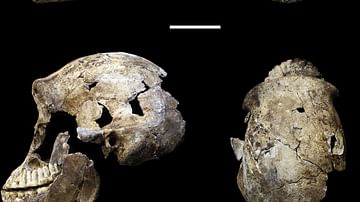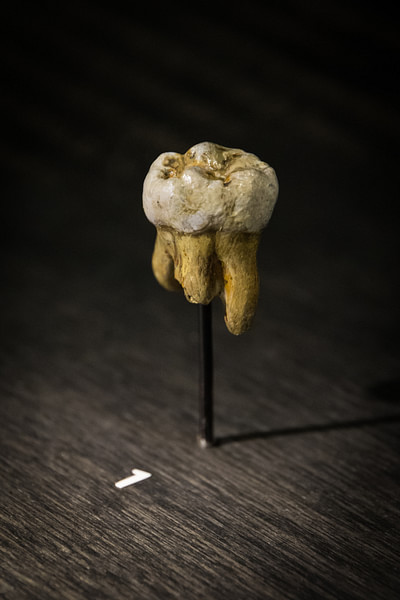
The Denisovans are an extinct group of fossil humans who, along with their sister group the Neanderthals, also share an ancestor with Homo sapiens. Thus far, they are known only from Denisova Cave in the Altai Mountains in Siberia, where they first appear to have entered the stage from perhaps as early as 287,000 years ago (or, conservatively, from around 200,000 years ago). Their latest known presence was quite a bit later – around 55,000 years ago – which indicates the Denisovans called the Altai region their home, at least at certain times, over a period of well over a 100,000 years.
Within the cave, sediments have thus far yielded fossil remains belonging to a grand total of four known Denisovan individuals as well as, interestingly, a fragment of a long bone that belongs to a female who had a Neanderthal mother and a Denisovan father. Indeed, other, fully Neanderthal remains have been recovered from Denisova Cave, too, and the evidence suggests that both groups lived, met, and occasionally interbred with each other over an approximate time span of 150,000 years. To find a first-generation mixed specimen when so few specimens have been found to date is astonishing, and it helps bolster the already established idea that during the Late Pleistocene whenever different groups met genetic exchange was not at all uncommon. Denisovan DNA not only showcases the fact that they had liaisons with Neanderthals but also that they interbred with an unknown archaic hominin group that branched off from the human lineage at least 1,000,000 years ago, as well as with Homo sapiens ancestors of today's Melanesians living in Southeast Asia and Oceania. As this last event seems to have happened somewhere in Southeast Asia, far away from the Altai Mountains, we think the Denisovans may have been far more widespread than their currently only known resting place betrays.
Discovery
Nestled in the Altai Mountains in Siberia, near the point where modern-day Russia, Kazakhstan, China, and Mongolia meet, is Denisova Cave. The cave is formed in Silurian limestone and consists of three chambers – the Main Chamber, East Chamber and South Chamber – that together cover around 270 square metres. First explored by scientists in the 1970s CE, the cave's excavations in subsequent decades have led to the discovery of artefacts belonging to the Middle Palaeolithic and Upper Palaeolithic industries, which clued us in about the likely presence of Neanderthals and Homo sapiens at some point in time. A real surprise hit home in 2008 CE, when a previously unknown human was added to this site's already seemingly busy track record: the finger bone of a young female was unearthed there and, when DNA was successfully extracted, it turned out she belonged to a distinct type of hominin that was dubbed the Denisovans. Denisova Cave was thus a true hotspot.
The girl, known as Denisova 3, lived between 52,000-76,000 years ago and paved the way for a previously unidentified male molar of a similar age, known as Denisova 4 and found in 2000 CE, to be attributed to her species, too. The only other two fossils to receive the Denisovan nametag so far are two further molars: one permanent molar belonging to a male, found in 2010 CE, known as Denisova 8 (between 105,600-136,400 years old); and a deciduous molar belonging to a very young girl who lived the furthest back in time, her dates coming in between c. 122,700-194,400 years ago. The true blockbuster came in 2012 CE, though, with the discovery of a long bone fragment of the aforementioned female who had a Neanderthal mother and a Denisovan father and lived between c. 80,000 and c. 120,000 years ago.
Besides these newcomers the remains of two full Neanderthals have also been found and, taken together with DNA found in sediments, we think Neanderthals intermittently occupied Denisova Cave between c. 193,000 and c. 97,000 years ago. However, despite the presence of Initial Upper Palaeolithic tooth pendants and bone points dated to between 43,000-49,000 years ago that seem to have a Homo sapiens flair about them (and represent the earliest known occurrences of such artefacts within northern Eurasia), no modern human bones or leftover bits of DNA have as of yet raised their flags from within Denisova Cave. These artefacts do postdate the latest known Denisovan presence in the cave, but it is, of course, possible that Denisovans survived later (we only have a few bones to go on after all) and can claim maker's rights in the end. This is actually the theory that best suits our current (limited) data at this point in time.
Alternatively, the fact that we have found modern human remains that were dated to c. 45,000 years ago at a site called Ust'-Ishim, northwest of Denisova Cave, may hint at Homo sapiens' involvement in the creation of these pendants and points; they could conceivably have helped spread this culture in Denisova Cave's direction, as it would fit with Homo sapiens' general spread eastwards across Eurasia. A rich Upper Palaeolithic assemblage including a well-developed stone bladelet technology is known from Denisova Cave, too, starting at c. 36,000 years ago and lasting until c. 20,000 years ago, stretching the cave's human occupation from c. 300,000 to 20,000 years ago. It is interesting to note here that for both Denisovans and Neanderthals, DNA has been extracted from sediments in the cave from layers that pre-date the ones that contain the fossils, so the occupation timeframe is guided by more than just bones. Besides modern humans, we are not as of yet aware of any other humans surviving as late as 20,000 years ago, but because their presence cannot be confirmed the site's swansong is still shrouded in mystery for now.
Scratching the surface
Impressively, despite the scarce amount of material associated with the Denisovans, both archaeology and science have come to the rescue and are allowing us to uncover some initial information regarding this species' specifics. Sadly, we cannot reconstruct their faces or bodies as of yet, but the three molars that were found show that the Denisovans had very large and robust teeth, which fit in a lot better with older hominins such as Homo erectus and even the Australopithecines than they do with our own tiny teeth, or even with the slightly bulkier Neanderthal ones. Big teeth seem to have been a typically Denisovan feature, then – at least for the ones living in the Altai Mountains. Regarding the rest of their features, DNA from our available Denisovans paints a picture of brown eyes set against dark skin, with brown hair topping things off, but, considering Denisovans were probably more widespread, it is likely that more variety existed. As we have seen above, both the details and broader features of the potential toolmaking skills of the Denisovans are hard to map out as of yet.
Most studies published on Denisovans are of the genetic kind and can tell us such neat things as, for example, how diverse the Denisovan population may have been. Strikingly, even though all of our current Denisovan fossils only stem from a single location, they seem to have been at least equally diverse as the Neanderthals were across their almost arrogantly widespread geographical range, as well as falling within the lower range of diversity seen in modern humans today. Of course, this Altai-based group of Denisovans could conceivably have been fairly isolated, and it is entirely possible that the Denisovans over their whole suggested geographical range may have been more varied. Some strokes of luck in finding additional fossils would be very, very welcome.
The wonderful world of genetics is also narrowing down where the Denisovans fit on the human lineage. It is clear that they are a sister group to the Neanderthals and share a common ancestor with them – the two groups are estimated to have diverged more than 390,000 years ago, perhaps between 430,000-473,000 years ago – but also that this Neanderthal-Denisovan branch shares an ancestor with our own Homo sapiens species. The branch that would lead towards both Denisovans and Neanderthals and the branch that would develop into modern humans split off from each other around an estimated 765,000-550,000 years ago. This evolutionary connection is only the beginning, though – the extent of our ties with both of these groups makes for even better news headlines.
Web of connected humans
By now, evidence is positively piling up that is finally overthrowing the old idea of linear evolution (i.e. one species evolves into the next, which evolves into the next, and so forth). As John Hawks suggests, the evolutionary history of the genus Homo probably looked more like a river delta, with streams weaving in and out, connecting and disconnecting, some branching off and landing in the sand and others continuing on. Different groups of humans met and interbred at various times and places, with genes being exchanged all over the place. Evolutionary geneticist and Ancient-DNA pioneer Svante Pääbo summarises this as follows: "... our ancestors were part of a web of now-extinct populations linked by limited but intermittent or something perhaps even persistent, gene flow." (Pääbo, S. 'The diverse origins of the human gene pool', 313).
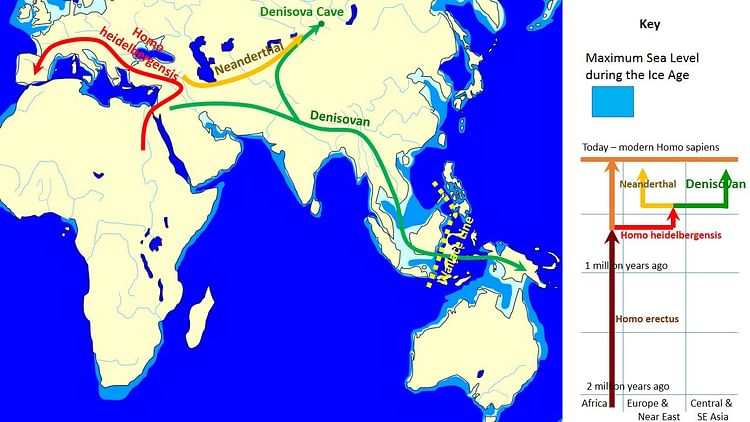
Our ever-helpful Denisovans have greatly served to underpin this notion because apart from the already known gene flow from Neanderthals into non-African modern humans (~2% Neanderthal ancestry), we now know there was also gene flow from Neanderthals into Denisovans; from an unknown archaic human into the Denisovans; and, around an estimated 44,000-54,000 or 31,000-50,000 years ago, from Denisovans into the ancestors of present-day Melanesians living on Southeast Asian islands and in Oceania (~2-4% Denisovan ancestry) – that is, Homo sapiens. This fairly big chunk of Denisovan DNA in Melanesians leads us to think they must have been more widespread than just the Altai Mountains. Furthermore because the modelled date for the youngest Denisovan fossil (Denisova 3; 51,600-76,200 years ago) pre-dates these calculations for when modern humans and Denisovans got it on, if both sets of dates are correct this would imply the Denisovans from the Altai Mountains either survived later than we know of now or that another Denisovan population outlived the Altai ones and interbred with modern humans, wherever they lived. Either way, the Denisovan component that entered the modern human gene pool also occurs in diluted version across the Asian mainland and the Americas and, at lower levels, it is widespread among modern humans in general, thanks to our wanderlust and desire to migrate all over the place.
The cool thing is, when Homo sapiens began spreading across Eurasia in greater numbers from around 60,000 years ago onwards, they were the relatively new kids on the block and ended up genetically benefitting from the exchange with the long since established Neanderthals and Denisovans. We already knew that Homo sapiens stole some skin and hair colour genes that were more suited to the northern ranges of the world when they interbred with Neanderthals, but they also gained a nice immune system boost from both of these species, who were already very much adapted to local Eurasian pathogens while Homo sapiens was not. This would have helped defend modern humans against the new array of parasites and bacteria. More traits that are courtesy of the Denisovan mixing are coming to the fore, too, such as the ability of Tibetans to cope with dizzyingly high altitudes.
However, just like with the cosy connection with the Neanderthals, it seems the Sapiens-Denisovan connection also caused some problems. Certain bits of DNA we inherited from them turned out to be harmful and were aggressively selected against, and it seems male mixed children may even have been sterile, indicating that although these groups of humans shared ancestors and could obviously make babies together, they were actually different enough to only just be biologically compatible.
The future
It is incredible that through a few fossils and accompanying titbits belonging to only a few individuals, from one cave nestled high in the Siberian Altai Mountains, scientists have managed to extract enough information to fill an entire definition on this website. To really paint a proper picture of who the Denisovans were, what it would be like to stare into their faces, how tall or stocky they were, and what their lifestyle and culture was actually like, how far spread out they were across the world and who exactly they bumped into, we need to get digging and get very lucky. More Denisovan-related finds would help to balance out our information and stretch it beyond mostly genetics. Bring on the future so we can fill in the past, please.




